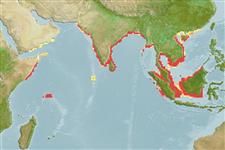Environment: milieu / Klimaatzone / Diepte / distribution range
Ecologie
marien; brak water pelagic-neritic; amfidroom (Ref. 51243); diepte 0 - 50 m (Ref. 189). Tropical; 25°N - 5°S, 46°E - 117°E (Ref. 189)
Indian Ocean: Karachi eastward to the Andaman Sea and Penang. Western Central Pacific: Singapore south to Barito River, Kalimantan).
Grootte / Gewicht / Leeftijd
Maturiteit: Lm ? range ? - ? cm
Max length : 17.0 cm SL mannelijk / geslacht onbekend; (Ref. 189)
Dorsale stekels (totaal) : 0; Anale stekels: 0; Anale zachte stralen: 80. Body tapering, belly rounded in front of pelvic fins, with 5 to 7 + 9 = 12 to 15 keeled scutes from just behind pectoral fin base to anus. Maxilla almost or just reaching to edge of gill cover. Pectoral fin with 6 long filaments; the branched fin rays longer than those of pelvic fin.
Body shape (shape guide): elongated; Cross section: compressed.
Occurs in fully saline water along coasts and in estuaries, but able to tolerate at least some degree of freshening (e.g. at Aluhaluh on Barito River, Kalimantan). Museum collections suggest that this species is common.
Levenscyclus en paargedrag
Maturiteit | Voortplanting | Paaien | Eieren | Fecunditeit | Larven
Spawn in school (Ref. 205).
Wongratana, T., T.A. Munroe and M. Nizinski, 1999. Order Clupeiformes. Engraulidae. Anchovies. p. 1698-1753. In K.E. Carpenter and V.H. Niem (eds.) FAO species identification guide for fishery purposes. The living marine resources of the WCP. Vol. 3. Batoid fishes, chimaeras and bony fishes part 1 (Elopidae to Linophrynidae). FAO, Rome. (Ref. 9822)
Status op de Rode Lijst van het IUCN (Ref. 130435: Version 2025-1)
Gevaar voor de mens
Harmless
Gebruik door de mens
Visserij: visserij voor eigen gebruik
Tools
Speciale rapporten
Download XML
Internetbronnen
Estimates based on models
Preferred temperature (Ref.
123201): 26.5 - 29.3, mean 28.6 °C (based on 618 cells).
Fylogenetische diversiteitsindex (Ref.
82804): PD
50 = 0.5001 [Uniqueness, from 0.5 = low to 2.0 = high].
Bayesian length-weight: a=0.00282 (0.00126 - 0.00632), b=3.10 (2.92 - 3.28), in cm total length, based on LWR estimates for this Genus-body shape (Ref.
93245).
Trofisch niveau (Ref.
69278): 3.3 ±0.4 se; based on size and trophs of closest relatives
Weerstandsvermogen (Ref.
120179): Hoog, minimale populatieverdubbelingstijd minder dan 15 maanden (Preliminary K or Fecundity.).
Fishing Vulnerability (Ref.
59153): Low vulnerability (11 of 100).
🛈
